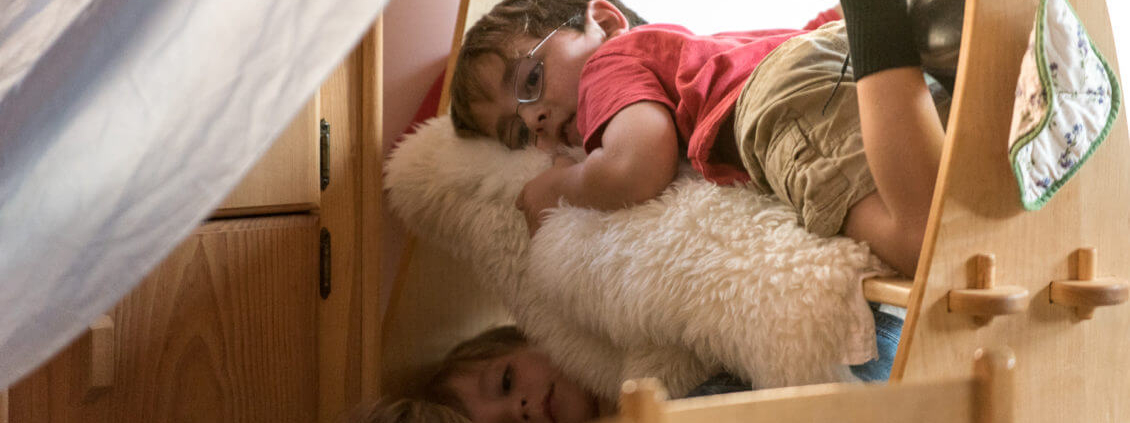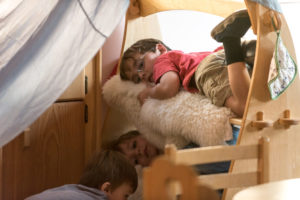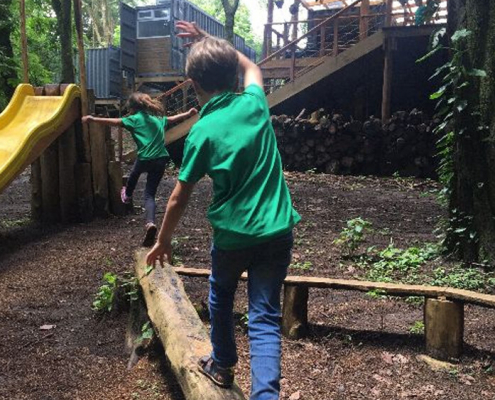Building Forts and Minds: The Importance of Child Built Space
Article written by The Waldorf School of Philadelfia
«In these secret places, children develop and control environments of their own and enjoy freedom from the rules of the adult world.”
Educational and environmental psychologists, along with educators in the field, have taken a keen interest in fort building. It’s a constant presence in early and middle childhood, the creation of secret places, often in plain site, and the experts agree that den, fort or secret space creation offers a host of cognitive and psychological benefits for the developing child.
The most comprehensive review of this research comes from architect, Maria Kylin, at the Swedish University of Agricultural Sciences. She identifies the three prominent scholars as Roger Hart, David Sobel, and Mark Powell, and compiles their research, along with dozens of other studies, that contribute to the comprehensive picture that is child-led fort building.
New York’s City University’s environmental psychologist, Roger Hart, first noticed secret space building and its importance in the 1970s and specifically noted the psychological importance these places for children in terms of control and order.
David Sobel of Antioch University New England, agrees that control is a major factor in this type of play and its importance to children. In his book, Children’s Special Places: Exploring the Role of Forts, Dens, and Bush Houses in Middle Childhood, he says,“In these secret places, children develop and control environments of their own and enjoy freedom from the rules of the adult world.”
The creation of something new is not accomplished by the intellect but by the play instinct acting from inner necessity – Carl Jung
Maria notes this theme of “control” as well, saying, “The common factor in the experience of the den as a social and a secret place is the sense of control that children feel they have, both over the den as a physical space and over the other children who share the den.”
But it extends beyond a simple need to control their personal world. Montessori Teacher and Education Administer, Mark Powell, found that social control was also key since order and control extended into social hierarchy and culture among children. He notes that, during and after fort building, rules were established and managed among the children to a point where he felt fort building was an excellent training ground for social competence.
In the realm beyond control and social culture, The Islington Play Association in the UK outlines even more perceived benefits of fort play in the guide for “playworkers” titled: Children’s Places of Secrecy and Play: A Playworker’s Guide to Dens and Forts. They speak to the privacy and solitude fort play grants children and notes how essential alone time is for a child’s imaginative play and development of an “internal quiet voice.”
But mostly, they discuss the importance of forts in terms of a child-created space, custom-made to suit the child’s specific needs. “When children build new spaces for play, they create a new world to experience, and that experience creates a new world – one that runs according to different material and social rules. What this means is that play gives children the opportunity to change their world to suit them. When children construct their own play environments, they naturally create ones that are most responsive to their needs, both at the moment and in terms of their long-term development. The benefits to the children are clear – stronger senses of self and community, belief in one’s own abilities to construct, adapt and demolish, the chance to identify and satisfy one’s own social, material and spatial needs.”
Forts at School
Waldorf early childhood programs nurture and protect the young child’s sense of wonder and imagination
Our role, as educators, is to respect these sacred places children build and to create environments that encourage their creation. Early childhood classroom design, in Waldorf Education, gives children space and materials to build these special places that help them learn in developmentally appropriate ways. Our classroom’s large free spaces are ideal for building and linens, scarves, blocks, along with empty mobile and modular shelving along with other elements often lead young ones to create these spaces indoors.

Out on the open playgrounds, older and younger children alike have plenty of space and material to make these spaces. And, most importantly of all, they are given the time needed at recess to create and cultivate these spaces together.
Forts at Home
Parents can encourage fort building at home as well. The New York Times asked prominent architects for their advice on how to best help children make special places inside their homes in their article, Lessons in the Art of Pillow Fort Construction. As a prime example of the pro tips offered, Dallas architect, Bob Borson, says, “Use sheets for the roof, since they’re lighter than blankets. Couches are a great anchor. And umbrellas are great for super fast fort construction. Just throw a sheet or blanket over the top of a big golf umbrella — or two, if you have them — and you’re all set.”
For the visual learners, check out this page at Pinterest, which offers examples of the best of the best from a simple cardboard box or sheet on a string to elaborate couch and outdoor creations for the children at home and in all of us.
Discover Waldorf Education
For fort building in action visit a Waldorf early childhood classroom. Discover the mixed-age Pre-K and Kindergarten program serving children ages 3-5 years of age at the Waldorf School of Philadelphia. Children work together in mixed-age groups in our pre-academic, play-based program that provides the strong foundation needed for the academic work of the grades program.
The home-like environment of a Waldorf early childhood classroom is carefully prepared for the developmental needs of the young child. Warm, nurturing, inviting and intentionally filled with beautiful, natural elements including pieces of wood, seashells, beeswax for modeling and handcrafted dolls and toys to encourage children to create, imagine and wonder. Their day breathes with a natural rhythm and nurtures them with folk tales, puppetry, and community.
Taught by Waldorf teachers specifically trained in early childhood education, Waldorf early childhood programs nurture and protect the young child’s sense of wonder and imagination. Children learn how to cut fruit for sharing, roll dough for baking fresh bread, and how to finger-knit with organic plant-dyed yarns, a practice that develops fine motor skills and teaches them how to recognize mathematical patterns.









